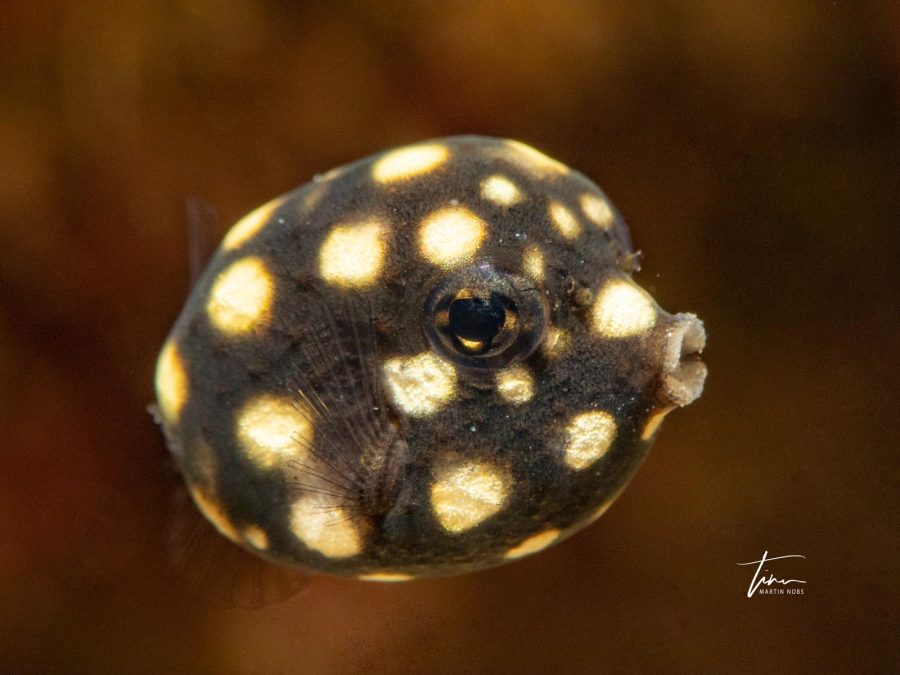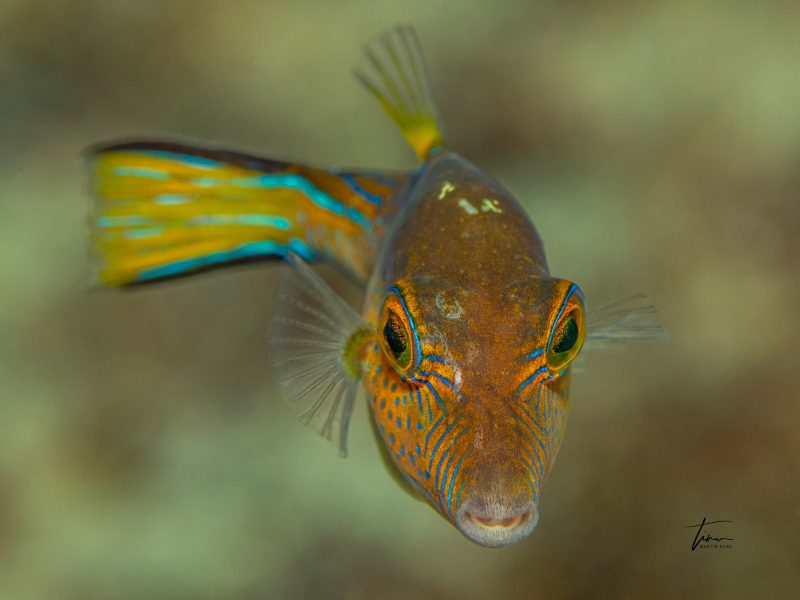How to Take Charismatic Portraits of Marine Life

It could be said that many people are more often drawn to photos of land-based mammals, as they are easier for us to relate to.
However, underwater photographers should be aware that many of the techniques used to capture engaging, charismatic portraits of wildlife on land can also be applied, with some changes, to underwater wildlife photography.
In this article, we will investigate some of these techniques to help you take characterful portraits of marine life.
Taking any photos underwater is notoriously tricky. As divers float and do not stand on the ground, and the water is always in motion, it’s extremely difficult to keep the camera steady. A big difference to land-based photography is the way you manage your lighting because, when underwater, natural light is absorbed and colours get lost in the depth.

For all underwater photography, and particularly when pursuing charismatic portraits of marine life, a flashlight, set of strobes, or a torch is absolutely necessary to get sharp, vibrant (and therefore engaging) pictures.
And of course, we have to take care of our buoyancy so that we do not harm or damage any marine life, such as corals, sponges, and small animals living on the sea floor.
So we are already combatting multiple factors when shooting underwater, just to get basic portraits of the species we are aiming to photograph! But once you have these things under control, here are some additional tips for capturing charisma in your underwater portraits.
Eye contact in underwater portraits
The eyes of any animal are most likely the first thing we look at in a picture so, even when underwater, we have to make sure that they are in focus and sharp. Having pin-sharp eyes makes a huge difference to the overall quality of your image. However, fish are constantly swimming, so this can be quite a challenge!
Choose single point autofocus (one focal point or box), as this is the most accurate and lets you decide exactly where you want the camera to focus. If you use continuous autofocus, when you half press your shutter button your camera will keep focusing on your chosen spot, even if you move slightly.
Always focus on the important part of the image; for most creatures, this will be the eye(s), but some marine life do not have these defining ‘facial’ features. For a nudibranch, for example, focus on the rhinophores, which is their most ‘defining’ feature.
When you are happy with the composition, press the button and take the photo!
Read more: Understanding Autofocus Points and Modes
Getting down to eye level
As with most other wildlife photography, it is important to be at eye level with the animal in the image. The effect achieved by this is so much more meaningful; the viewer is more likely to feel engaged with your photo because they will feel more like a part of the scene.
However, be aware that there are subjects that can be very beautiful when shot from above, like the intricate pattern of a sea turtle shell, or a colourful sea star. Shooting from above on occasion can create classic portraits of a species’ most recognisable features.
Personally, I like to shoot mainly from straight on or from slightly below, as I find I can achieve more personable photos with this technique.
But remember, always keep your buoyancy sorted and do not ever lie on the seafloor. If this seems like your only option, you would do better to wait a moment and see if your subject moves to another spot where you have better possibilities.
Disturbing the sea floor can not only be harmful to marine life, but can also stir up sand and silt and ruin the clarity of your image.
Top tip: To get the attention of your subject underwater, (and get them to possibly make eye contact with you), you can try to gently scratch a rock with your fingernail or blow some extra bubbles.
You might be impressed by how many curious fish will come to see what is going on (though you should never intentionally try to scare or disturb the subject in question)!
Read more: Underwater Photography Ethics and Code of Conduct
Deciding on your background
Personally, I love to play with my settings and aim to create negative space in my backgrounds. This effect makes the animal stand out even more, and draws our viewer’s attention to the subject in a real ‘portraiture’ style. To achieve this effect, you should compose your image so that your subject stands freely, with nothing in the background that can be illuminated by the strobe.
Remember that with a small f-stop number, the background remains bright, so you can capture the beautiful blue water of the sea, creating a lighter, brighter, more natural style of portrait.
With a large f-stop number or a faster shutter speed, the background becomes rather dark or even black, which can create a very dramatic effect in your portraits.
Read more: How to Achieve a Black Background in your Underwater Photography
Choosing your lighting
As mentioned above, light is very important when taking underwater portraits. On my set up I have a flashlight connected to the waterproof housing of my camera, and a torch which I mostly use as a focus light.
Your camera needs to see contrast to focus properly, and a focus light helps your camera see contrast better, especially when your subject is not particularly detailed.
Remember that strobes only provide lighting when you press the shutter; you can only see the result after you have taken the photo. Torches provide continuous lighting; this means you can see what your image is going to look like before you press the shutter.
However, torches are not as bright (entry level torches are around 1000-2000 lumen), which means they do not light objects that are further away. Strobes are far brighter (entry level is 20,000 lumen). They reach further and help freeze motion as they flash so quickly. Because of this bright light, you can make colours really pop underwater.
In my opinion, torches are harder to use as you have to adjust your camera settings to get the right exposure. Strobes are far easier to use as you adjust the strobe strength to get the right amount of light on your subject.
Good lighting can aid in creating a charismatic portrait. With a torch, for example, you can cast lighting down one side of a fish’s face to create a more artistic, characterful portrait – mysterious even!
In shallow water you can play with natural light and sunlight, but at depth you will definitely need an external light source. The pictures above are taken with natural light, a flash, and using just a torch.
Read more: 8 Tips for Creating Amazing Lighting in Underwater Photos
Choosing the angle
The angle you choose for your portrait is also an important factor to consider.
Quite often you can forget about the rule of thirds in underwater photography, as you really want the eye of the subject right in the centre of your image. Bear in mind too that your subject might be prettier from the side than from the front: from the side, the subject can appear more two dimensional, perfect for ID shots.
A slight shift to 3/4s can give a more dimensional image, and make the subject look like it is ‘popping out’ of the frame. Same fish, different angle in the following pictures:

Shooting head-on
Shooting head-on is one of my favourite angles when it comes to shooting fish! Fish faces can look very funny from a frontal view. They have no eyelids and the eyeball is mostly translucent, standing out from the fish’s head. With the flashlight this mostly creates a nice catchlight that brings the eyes to life.
The colours of a fish’s eyes can vary greatly. Many of them have vibrant colours, which are a good way to draw a viewer’s attention directly to the eye, and make them think that they are looking at the animal through your camera themselves.
However, getting a good head-on portrait of a fish face is no mean feat. Fish never hold still, swimming away from divers all the time because they are scared away by flashlights or noisy bubbles. Many can also move their eyes independently, and you’ll end up with shots of one eye looking at you and the other looking somewhere else!
It requires a lot of patience and many out-of-focus pictures to get that perfect head-on portrait. Once you have chosen your subject, stay as calm as possible and wait until the animal is looking straight at you. Then focus, and press the shutter.
Close-up and filling the frame
Close-up, or macro, is a nice way to show details of very small critters and, believe me, there are so many of them in our oceans. It is most important that you do not disturb or frighten away your subject when you approach closely for a shot like this.
With a zoom lens, you can stay a bit further back and zoom in. But when shooting with a macro lens, keep in mind that many macro lenses have a fixed focal length, which will not allow for zooming in.
If you use a small aperture (e.g., for macro: f/8 for compacts, f/18 for mirrorless, f/20 for DLSR), your depth of field will be better and you will have a sharper image throughout.
I also recommend using faster shutter speeds for your portraits. We are in constant motion under the water, and so are your subjects, so a fast shutter speed will help freeze your subject and give a sharper image. This is integral to creating a strong portrait image.
And of course, being up close and having the viewer’s main focus placed on your subject, rather than the environment or how it fits into the environment, will help create a more engaging, charismatic portrait of your marine subject.
Read more: Top Tips to Improve Your Underwater Macro Images
Capturing characters
Another useful way to help the viewer feel engaged with your image is trying to capture the character, or a certain behaviour, of the animal in question. For example, a baby trunkfish is (in my opinion) one of the cutest things on earth, being only the size of a pea and having a facial expression that you simply cannot resist loving.
On the other hand, seahorses often look a bit confused, like they are saying ‘hey you, what are you doing here?’ You can add a little extra spice to your images by looking for such expressions, or perhaps by finding an unusual angle of an animal which has never been photographed before.
You want to make your viewers say ‘wow, I have never seen anything like this before!’
In conclusion
It can seem like a daunting task to take charismatic portraits of marine life, when so much of the underwater world feels so extra-terrestrial to us. However, the techniques described above can help you capture truly characterful images of the wonderful wildlife found under the sea.
Top tip: dare to be different! We all see things differently, so photograph your subjects how you see them, and your shots will always be unique to you.
By no means are the above tips rules that must be applied to your own photography– interpret them how you wish, and trust your gut instinct. Most importantly, have fun and love what you do. Good luck and happy bubbles!
















